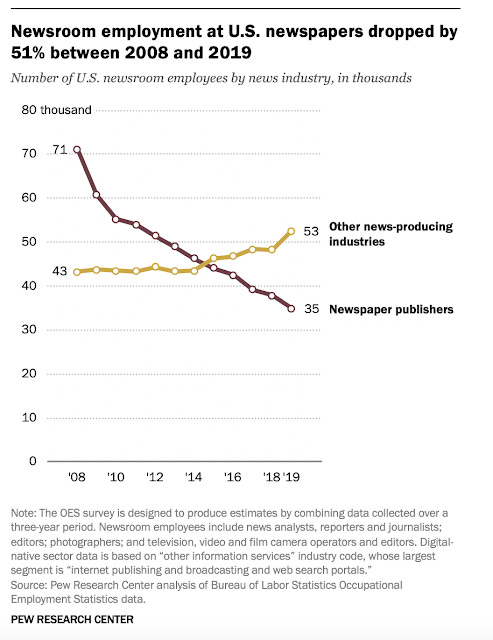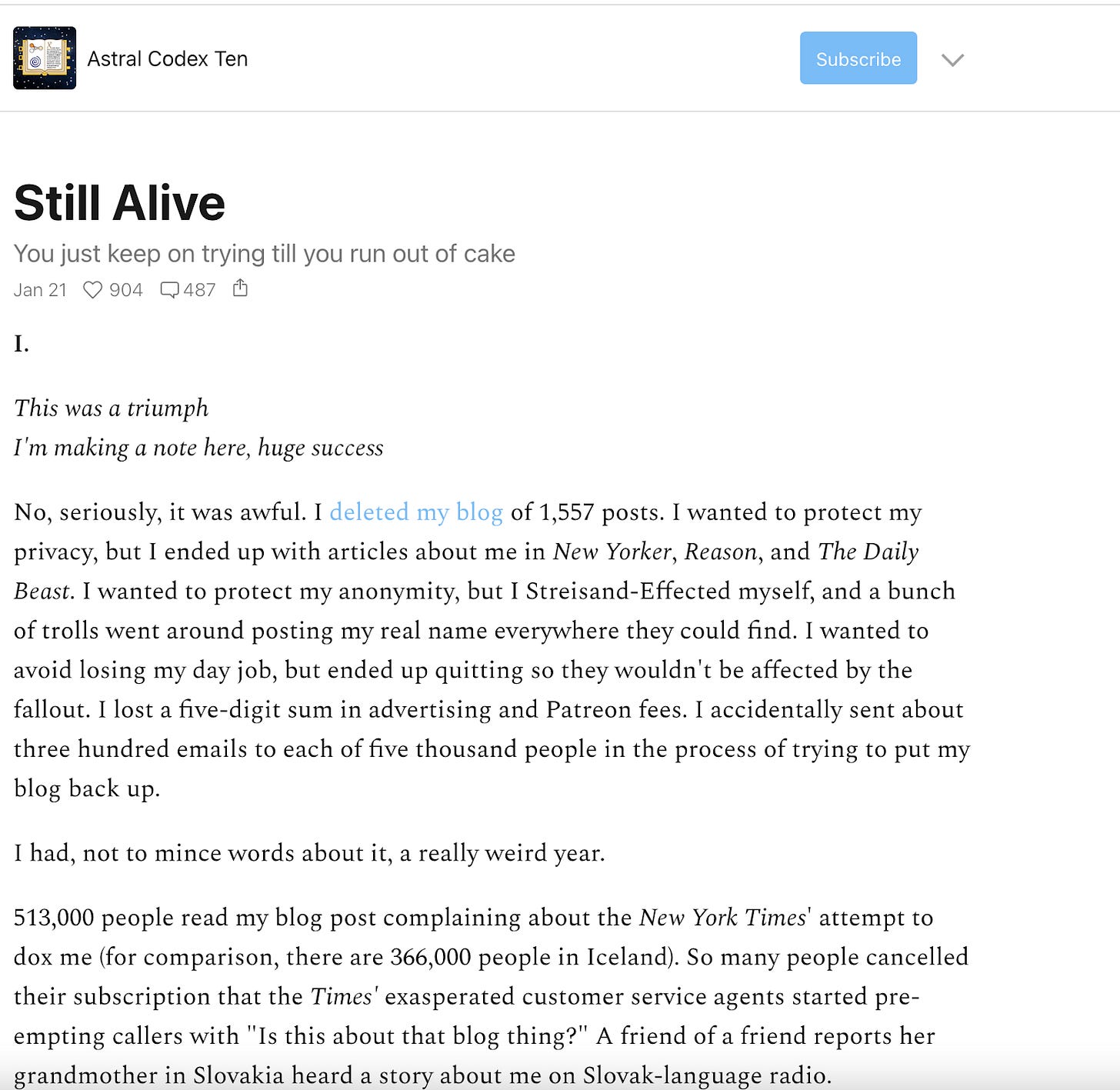Substack: Most Interesting Consumer Startups of 2021 (Part 2)
This post is the first in a small series on the new wave of hyperinteresting consumer tech products that are most likely to have had society-level impact in 5 years. My first two posts are on Clubhouse and Substack [1]. Both are social network and media platforms of different types, and both have an opportunity to displace multiple existing services including Twitter. This post on Substack focuses on the creation of journalist-entrepreneurs[2] and the transition of the media world (at least in part) back to subscriptions. Another post on Clubhouse explains why it is the first new interesting social platform in a decade.
Substack.
The other potentially transformative company of this era is Substack. Substack is changing the nature of journalism, reporting, blogging, podcasting, and content creation. Strikingly, it is turning a generation of content creators and journalists into business owners.
The news industry has had a tough two decades. The emergence of online channels and online advertising in the 1990s and 2000s disrupted the news industry in the following ways:
New channels to reach users/readers. Newspapers used to have local monopolies or oligopolies. This was changed by the Internet, where it was suddenly easy to use any news source from any geography. Later, social networks like Twitter and Facebook built massive audiences and drove more news distribution and interaction.
A change in cost structure. Newspapers & magazines had enormous costs associated with printing presses and the physical production and distribution of their content. Digital media emerged without these baked in costs, while large incumbent brands like the NY Times and Washington Post could suddenly broaden their reach. This squeezed traditional mid-tier media with its physical infrastructure and (for niche or local brands) more limited reach.
ROI-based advertising. Local news made a large portion of its profits off classified ads. Craigslist disrupted the classified model, while online ad spend became more ROI focused with the emergence of Google. Newspapers suddenly had to compete for advertising spend with large technology platforms when before they had local monopolies or oligopolies.
These changes caused major shifts in the economics of the news business and led to the destruction of many local news outlets, cuts in journalism staff, and a decrease in options for talented writers. The disruption of traditional media led to (a) consolidation of media behind a few major brands (b) bankruptcy for many small, local news outlets (c) the morphing of individual journalist political views farther left on economic issues. The livelihood of journalists was being hurt by technology platforms and social media, and may explain part of the journalistic backlash against these platforms in recent years.

Substack allows anyone to:
Easily create and publish content.
Build a subscriber base.
Convert Twitter or other followers into regular subscribers and readers by building a direct channel outside of Twitter or other social media gatekeepers. It also allows for targeted niche writing.
Monetize that subscriber base by charging a monthly or annual fee.
This is key. A subset of journalists can make 2X-20X more on substack than at their old job. This has a few important implications below (see “Journalists Entrepreneurs” below.).
The media platforms lose leverage over journalists. In the land of few jobs and few media brands, an individual journalist or writer needs to comply with the whims of its management and fear colleagues opinions and politics. If there is a ready outlet for individuals like Substack, they are not constrained in their industry. Like all entrepreneurial endeavors, this will not be for everyone. Media brands will continue to thrive, but we will also see a blossoming of individual brands and niche publications that are self sustaining.
Substack uses cases may include:
General purpose blogging platform and newsletter distribution. Subscriptions are key.
The blogging/newsletter comments are self explanatory and opens up a wide variety of use cases from consumer to enterprise.
By monetizing initially via a subscription-model Substack avoids some of the conundrums many content platforms face early on. It also creates a direct financial incentive for writers on the platform to build their userbase and readership by giving them revenue tied directly to usage. Ads based models are less able to incentivize content providers directly, nor do they create an entirely new media business model like Substack does.
Content platform and new media outlet. This is the product direction Substack is getting most of its attention for now. As journalists and writers leave traditional media, it appears they are largely going to Substack (and to some extent Ghost). There have also been interesting group migrations to Substack where people are inventing new media outlets and groups on the platform with multiple writers at once. This does not mean traditional media is "over" - it will of course continue to thrive. However many brands may now also grow and flourish on Substack.
Local news outlets. One of the challenges of local news was its cost structure. Each paper needed to physically produce papers, sell inventory to advertisers, and distribute. This was monetized in part by classifieds, which CraigsList disrupted. Substack allows overhead to be cut substantially and a small number of local journalists can thrive on this direct pay platform. It will be interesting to watch if Substack allows for the flourishing of a new wave of local journalism, supported by subscriptions from a small, happy to pay audience.
Investigative journalism for everything. Substack allows the re-emergence of investigative journalism for almost any topic that has a userbase willing to pay a subscription for it. Do you want detailed updates on the Chinese government? The Keystone Pipeline? Climate change? The move of tech to other cities? Substack creates a way for writers to monetize insights directly.
Distributed content about everything. Will the next music magazine, fly fishing journal, or SlaterStarCodex live on Substack?
Serialized novels. Charles Dickens used to write his novels as serial installments of roughly twenty, 32-page installments per novel. One can imagine a world where novelists are paid a subscription to continue to share novels or other longer form content as they go.
From front-page to inbox. From mainstream to niche. While the old paradigm of journalism was “get on the front page”, Substack is an interesting move towards “get in the inbox”. Society is moving from public to private content and mainstream to new fragmented niches. Part of this shift is driven by a fear of cancel culture, which appears to be evident in the newsrooms for a subset of journalists who shifted to Substack. Why deal with irate colleagues or a Twitter mob in public when you can be read quietly in private?
Enterprise use cases. They are a number of obvious use cases for marketers to use Substack as a writing/blogging and newsletter platform.
Subscriptions payment platform. Substack has built subscription payments for media. This can be extended for other influencer and content types and would be an interesting adjacency to enter.
Long term: Twitter replacement? Like Clubhouse, Substack may have a shot at displacing Twitter for some of its use cases.
Substack has a news and interest graph and content subscriber model. Substack’s broadcast based interest graph provides it some hooks on which to build a broader real time content platform on.
Assuming users can increasingly comment and interact with Substack content and each other, a nascent Twitter-like short form content product can start to impact the news and interest-graph side of Twitter.
Twitter recently bought Revue as a reaction in part to Substack. Intriguingly many journalists are on Substack in part due to cancel culture and censorship. Given Twitter’s increasing censorship, erm I mean, "content moderation", of scientific and political content, it will be interesting to see the trade off between censorship and distribution reach. I would guess distribution helps overcome a lot of other considerations & Twitter's new product has a chance to do well with much of the mainstream.
Journalist-Entrepreneurs
One of the most interesting societal transformations driven by Substack is converting a generation of journalists into small (and in some cases large) business owners. During the last two decades, journalists have suffered from the “creative destruction” aspects of capitalism - where the business model of their platforms were hurt and many journalists were laid off. This and other trends pushed journalists farther to the left on economic and other issues.
With the rise of Substack, journalists are suddenly benefiting from becoming the owners of their own media brands and businesses. In many cases they are making more money while maintaining editorial control of their own perspective and voice. Writers on Substack need to do all the things business owners need to do - attract customers, in some cases hire people and manage them, and run expenses - but also benefit financially from the upside of their work. It will be interesting to see how this adoption of direct business ownership shapes the writing and thinking of a generation of writers - and might end up being one of the biggest societal impacts of Substack. The financial reenfranchisement of the Fourth Estate may also shift the thinking of a society which consumes their content.

Thanks to Avichal Garg and Katherine Boyle for comments on this post.
NOTES
[1] Of course there will be some other product in private alpha that in hindsight will be super important too. Only the future knows what it is.
[2] This is all my own speculation and has nothing to do with actual company roadmaps.
OTHER POSTS
Markets:
Startup life:
Raising Money


